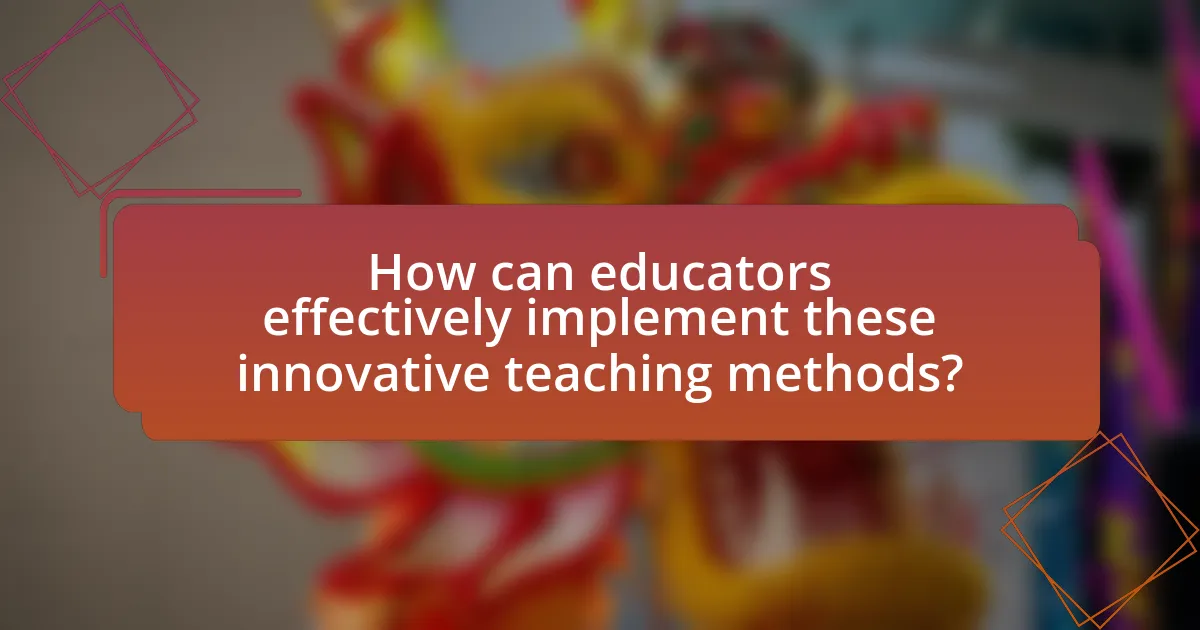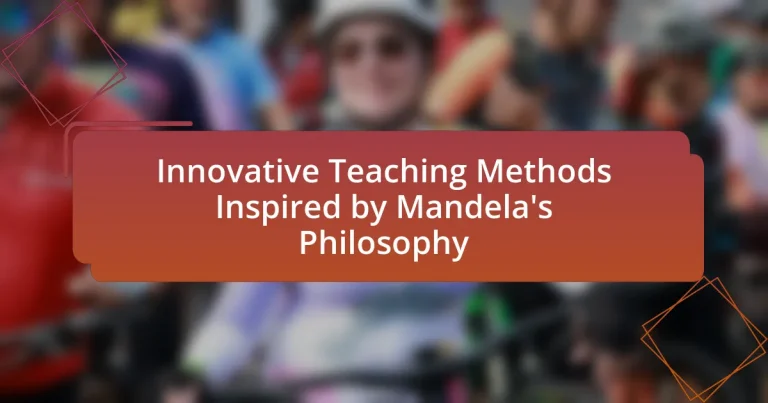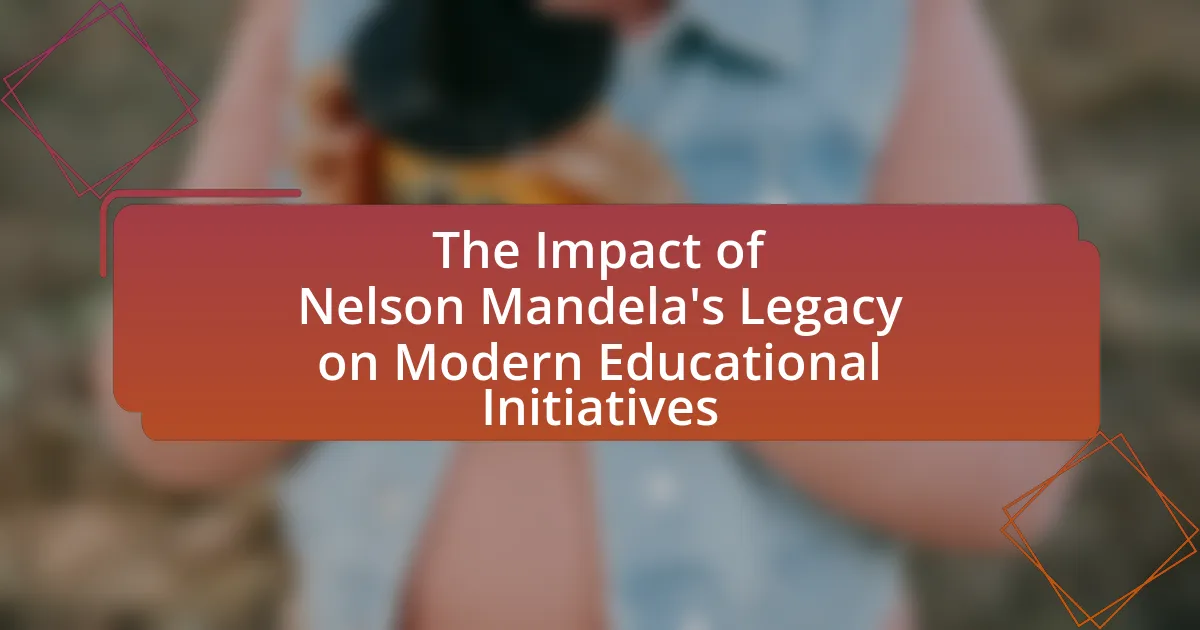Innovative teaching methods inspired by Nelson Mandela’s philosophy emphasize experiential learning, collaborative learning, and culturally relevant pedagogy. These approaches enhance student engagement and promote inclusivity, reflecting Mandela’s commitment to equality and social justice in education. The article explores how these methods influence modern educational practices, the principles derived from Mandela’s philosophy that can be applied in teaching, and the benefits of fostering critical thinking and collaboration among students. Additionally, it addresses the challenges faced by traditional teaching methods and offers strategies for effectively implementing innovative practices in the classroom.
What are Innovative Teaching Methods Inspired by Mandela’s Philosophy?
Innovative teaching methods inspired by Mandela’s philosophy include experiential learning, collaborative learning, and culturally relevant pedagogy. Experiential learning emphasizes hands-on experiences, allowing students to engage directly with their communities, reflecting Mandela’s belief in the importance of practical education. Collaborative learning fosters teamwork and communication, aligning with Mandela’s vision of unity and collective effort in overcoming challenges. Culturally relevant pedagogy integrates students’ cultural backgrounds into the curriculum, promoting inclusivity and respect for diversity, which Mandela championed throughout his life. These methods not only enhance student engagement but also prepare learners to contribute positively to society, echoing Mandela’s legacy of empowerment through education.
How does Mandela’s philosophy influence modern education?
Mandela’s philosophy influences modern education by emphasizing the importance of equality, social justice, and critical thinking. His belief that education is a powerful tool for personal and societal transformation encourages educational systems to adopt inclusive practices that promote diversity and equity. For instance, Mandela famously stated, “Education is the most powerful weapon which you can use to change the world,” highlighting the transformative potential of education. This perspective has led to the implementation of innovative teaching methods that prioritize collaborative learning, critical inquiry, and the development of social consciousness among students, fostering an environment where learners are encouraged to challenge injustices and think independently.
What key principles from Mandela’s philosophy can be applied to teaching?
Key principles from Mandela’s philosophy that can be applied to teaching include the emphasis on equality, respect for diversity, and the importance of education as a tool for empowerment. Mandela believed that education is the most powerful weapon which you can use to change the world, highlighting its role in fostering critical thinking and social responsibility. His commitment to inclusivity encourages educators to create environments where all students feel valued and heard, promoting collaborative learning. Additionally, Mandela’s focus on resilience and perseverance can inspire teaching methods that encourage students to overcome challenges and develop a growth mindset. These principles are validated by Mandela’s own experiences and advocacy for education as a means to achieve social justice and equality.
How do these principles enhance student engagement?
The principles inspired by Mandela’s philosophy enhance student engagement by fostering a sense of belonging and empowerment among learners. These principles emphasize inclusivity, respect, and collaboration, which create an environment where students feel valued and motivated to participate actively. Research indicates that when students perceive their learning environment as supportive and inclusive, their engagement levels increase significantly, leading to improved academic performance and retention rates. For instance, a study published in the Journal of Educational Psychology found that inclusive teaching practices positively correlate with higher student engagement and satisfaction.
Why are innovative teaching methods important in today’s classrooms?
Innovative teaching methods are important in today’s classrooms because they enhance student engagement and improve learning outcomes. These methods, such as project-based learning and collaborative activities, cater to diverse learning styles and promote critical thinking. Research indicates that classrooms employing innovative strategies see a 20% increase in student retention rates compared to traditional methods, as highlighted in a study by the Bill & Melinda Gates Foundation. This evidence underscores the effectiveness of innovative teaching in fostering a more dynamic and inclusive educational environment.
What challenges do traditional teaching methods face?
Traditional teaching methods face challenges such as lack of engagement, limited adaptability, and insufficient focus on critical thinking skills. These methods often rely heavily on rote memorization and standardized testing, which can disengage students and fail to accommodate diverse learning styles. Research indicates that students in traditional settings may experience lower motivation and retention rates compared to those in more interactive and student-centered environments. For instance, a study published in the Journal of Educational Psychology found that active learning strategies significantly improve student performance and engagement, highlighting the limitations of conventional approaches.
How can innovative methods address these challenges?
Innovative methods can address challenges in education by fostering critical thinking, collaboration, and inclusivity. For instance, project-based learning encourages students to engage in real-world problems, enhancing their problem-solving skills and teamwork. Research shows that such methods improve student engagement and retention rates; a study by the University of Washington found that project-based learning can increase student achievement by up to 30%. Additionally, incorporating technology, such as interactive simulations and online collaboration tools, allows for personalized learning experiences that cater to diverse learning styles, further addressing educational disparities.
What are some examples of innovative teaching methods inspired by Mandela’s philosophy?
Innovative teaching methods inspired by Mandela’s philosophy include experiential learning, collaborative learning, and culturally relevant pedagogy. Experiential learning emphasizes hands-on experiences, allowing students to engage directly with their communities, reflecting Mandela’s belief in the importance of practical education. Collaborative learning fosters teamwork and communication skills, aligning with Mandela’s vision of unity and collective effort in overcoming challenges. Culturally relevant pedagogy incorporates students’ cultural backgrounds into the curriculum, promoting inclusivity and respect for diversity, which Mandela championed throughout his life. These methods are validated by educational research that highlights their effectiveness in enhancing student engagement and learning outcomes.
How can collaborative learning be implemented in the classroom?
Collaborative learning can be implemented in the classroom by organizing students into small groups to work on shared tasks or projects. This approach encourages peer interaction, allowing students to learn from one another and develop critical thinking skills. Research indicates that collaborative learning enhances student engagement and improves academic performance; for instance, a study by Johnson and Johnson (1999) found that cooperative learning methods lead to higher achievement and greater retention of information compared to traditional teaching methods. By incorporating structured group activities, peer feedback sessions, and collaborative problem-solving tasks, educators can effectively foster a collaborative learning environment that aligns with innovative teaching methods inspired by Mandela’s philosophy.
What are the benefits of collaborative learning for students?
Collaborative learning enhances students’ critical thinking, communication skills, and social interaction. This approach fosters a deeper understanding of content as students engage in discussions, share diverse perspectives, and solve problems collectively. Research indicates that students involved in collaborative learning environments demonstrate improved academic performance, with a study by Johnson and Johnson (1999) showing that cooperative learning can lead to higher achievement levels compared to individualistic learning. Additionally, collaborative learning promotes a sense of community and belonging among students, which is essential for their emotional and social development.
How can teachers facilitate effective collaboration among students?
Teachers can facilitate effective collaboration among students by implementing structured group activities that promote teamwork and communication. For instance, using cooperative learning strategies, such as jigsaw or think-pair-share, encourages students to engage with one another and share diverse perspectives. Research indicates that cooperative learning can enhance student achievement and social skills, as demonstrated in a meta-analysis by Johnson and Johnson, which found that students in cooperative learning environments perform better academically and develop stronger interpersonal skills compared to those in competitive or individualistic settings. By fostering an inclusive atmosphere where students feel valued and responsible for each other’s learning, teachers can significantly enhance collaborative efforts in the classroom.
What role does critical thinking play in Mandela-inspired teaching methods?
Critical thinking is central to Mandela-inspired teaching methods as it encourages students to analyze, evaluate, and synthesize information critically. This approach aligns with Nelson Mandela’s belief in education as a tool for empowerment and social change, fostering independent thought and problem-solving skills. For instance, Mandela emphasized the importance of questioning societal norms and injustices, which critical thinking facilitates by enabling learners to assess their beliefs and the world around them. This method not only enhances academic performance but also prepares students to engage thoughtfully in democratic processes and community issues, reflecting Mandela’s vision of an educated and active citizenry.
How can educators foster critical thinking skills in students?
Educators can foster critical thinking skills in students by implementing inquiry-based learning strategies that encourage questioning and exploration. This approach allows students to engage deeply with content, analyze information, and develop their reasoning abilities. Research indicates that inquiry-based learning enhances critical thinking; for instance, a study published in the Journal of Educational Psychology found that students who participated in inquiry-based activities demonstrated significantly higher critical thinking skills compared to those who engaged in traditional learning methods. By creating an environment where students feel safe to express their thoughts and challenge ideas, educators can effectively cultivate critical thinking.
What activities promote critical thinking in the classroom?
Activities that promote critical thinking in the classroom include Socratic questioning, debates, problem-based learning, and collaborative group work. Socratic questioning encourages students to think deeply by challenging assumptions and exploring different perspectives. Debates foster critical analysis as students must defend their viewpoints and consider opposing arguments. Problem-based learning engages students in real-world scenarios, requiring them to apply knowledge and think critically to find solutions. Collaborative group work enhances critical thinking by allowing students to share ideas, challenge each other’s reasoning, and develop a deeper understanding through discussion. These activities are supported by educational research indicating that active engagement and dialogue significantly enhance critical thinking skills among students.

How can educators effectively implement these innovative teaching methods?
Educators can effectively implement innovative teaching methods inspired by Mandela’s philosophy by fostering an inclusive and collaborative learning environment. This approach encourages active participation and critical thinking among students, aligning with Mandela’s belief in education as a tool for empowerment. Research indicates that collaborative learning strategies, such as group projects and peer teaching, enhance student engagement and retention of knowledge. For instance, a study published in the Journal of Educational Psychology found that students who participated in collaborative learning scored significantly higher on assessments compared to those who learned individually. By integrating these methods, educators can create a dynamic classroom atmosphere that reflects Mandela’s vision of education as a means to promote social justice and equality.
What strategies can teachers use to integrate Mandela’s philosophy into their curriculum?
Teachers can integrate Mandela’s philosophy into their curriculum by emphasizing values such as equality, respect, and social justice. This can be achieved through project-based learning that focuses on historical events related to Mandela’s life, such as the anti-apartheid movement, allowing students to explore themes of resilience and activism. Additionally, incorporating discussions on human rights and the importance of community service can help students understand the relevance of Mandela’s teachings in today’s society. For instance, using literature that reflects these themes, such as works by South African authors, can provide context and deepen students’ understanding of the impact of Mandela’s philosophy on global human rights movements.
How can teachers assess the effectiveness of these methods?
Teachers can assess the effectiveness of innovative teaching methods inspired by Mandela’s philosophy through a combination of formative and summative assessments. Formative assessments, such as observations, student feedback, and reflective journals, allow teachers to gauge student engagement and understanding in real-time. Summative assessments, including standardized tests and project-based evaluations, provide measurable outcomes of student learning and retention. Research indicates that methods aligned with Mandela’s emphasis on critical thinking and social justice can lead to improved student performance, as evidenced by studies showing that students exposed to such methods demonstrate higher levels of critical analysis and empathy in their work.
What resources are available for teachers looking to adopt these methods?
Teachers looking to adopt innovative teaching methods inspired by Mandela’s philosophy can access a variety of resources, including professional development workshops, online courses, and educational literature. Organizations such as the Nelson Mandela Foundation offer training programs that focus on values-based education, promoting critical thinking and social justice. Additionally, platforms like Coursera and edX provide courses on transformative education practices that align with Mandela’s ideals. Research studies, such as “Teaching for Social Justice: A Critical Pedagogy Approach” by authors like Paulo Freire, emphasize the importance of these methods in fostering an inclusive classroom environment. These resources equip educators with the necessary tools to implement effective teaching strategies rooted in Mandela’s philosophy.
What are the potential challenges in adopting innovative teaching methods?
The potential challenges in adopting innovative teaching methods include resistance from educators and students, lack of resources, and insufficient training. Educators may resist change due to comfort with traditional methods, while students might struggle to adapt to new learning styles. A study by the National Center for Education Statistics found that 40% of teachers reported a lack of adequate training as a barrier to implementing innovative practices. Additionally, financial constraints can limit access to necessary technology and materials, further hindering the adoption of these methods.
How can teachers overcome resistance to change in educational practices?
Teachers can overcome resistance to change in educational practices by fostering a collaborative environment that encourages open communication and shared decision-making. This approach allows educators to voice their concerns and suggestions, which can lead to a sense of ownership over the changes being implemented. Research indicates that when teachers are involved in the planning and execution of new methods, they are more likely to embrace those changes (Fullan, 2007). Additionally, providing professional development opportunities tailored to the specific needs of teachers can enhance their skills and confidence, making them more receptive to innovative practices. Studies show that ongoing support and training significantly reduce resistance and improve the adoption of new educational strategies (Guskey, 2002).
What support systems can be put in place to assist teachers?
Support systems that can be put in place to assist teachers include mentorship programs, professional development workshops, and access to teaching resources. Mentorship programs pair experienced educators with novice teachers, providing guidance and support, which has been shown to improve teacher retention rates by up to 50%. Professional development workshops offer ongoing training in innovative teaching methods, enhancing teachers’ skills and effectiveness in the classroom. Additionally, providing access to teaching resources, such as digital tools and instructional materials, empowers teachers to implement diverse and engaging learning experiences, aligning with the principles of Mandela’s philosophy on education as a powerful tool for change.
What best practices should educators follow when implementing these methods?
Educators should prioritize student-centered learning when implementing innovative teaching methods inspired by Mandela’s philosophy. This approach fosters engagement and encourages critical thinking, aligning with Mandela’s belief in the transformative power of education. Additionally, educators should incorporate collaborative activities that promote teamwork and respect for diverse perspectives, reflecting Mandela’s emphasis on unity and social justice. Research indicates that active learning strategies, such as group discussions and problem-solving tasks, significantly enhance student retention and understanding (Freeman et al., 2014, Proceedings of the National Academy of Sciences). Furthermore, continuous assessment and feedback are essential to adapt teaching methods to meet students’ needs effectively, ensuring that all learners can thrive in an inclusive environment.
How can teachers create an inclusive environment that reflects Mandela’s values?
Teachers can create an inclusive environment that reflects Mandela’s values by fostering respect, empathy, and collaboration among students. This can be achieved through implementing cooperative learning strategies, where students work together in diverse groups, promoting understanding and appreciation of different perspectives. Research indicates that such collaborative approaches enhance social skills and reduce prejudice, aligning with Mandela’s emphasis on unity and equality. Additionally, incorporating culturally relevant materials and discussions about social justice can further reinforce these values, ensuring that all students feel valued and included in the learning process.
What ongoing professional development opportunities are beneficial for teachers?
Ongoing professional development opportunities beneficial for teachers include workshops, online courses, mentorship programs, and collaborative learning communities. Workshops provide hands-on experience with innovative teaching strategies, while online courses offer flexibility and access to a wide range of topics, including those inspired by Mandela’s philosophy of education. Mentorship programs facilitate personalized guidance from experienced educators, enhancing teaching practices. Collaborative learning communities foster peer support and sharing of best practices, which is essential for continuous improvement in teaching methods. Research indicates that teachers who engage in ongoing professional development are more effective in the classroom, leading to improved student outcomes.




